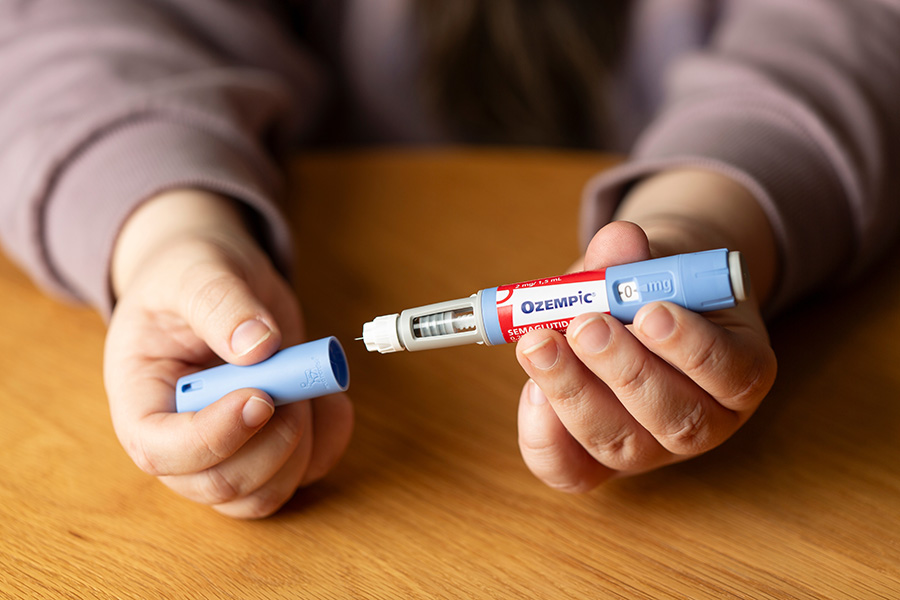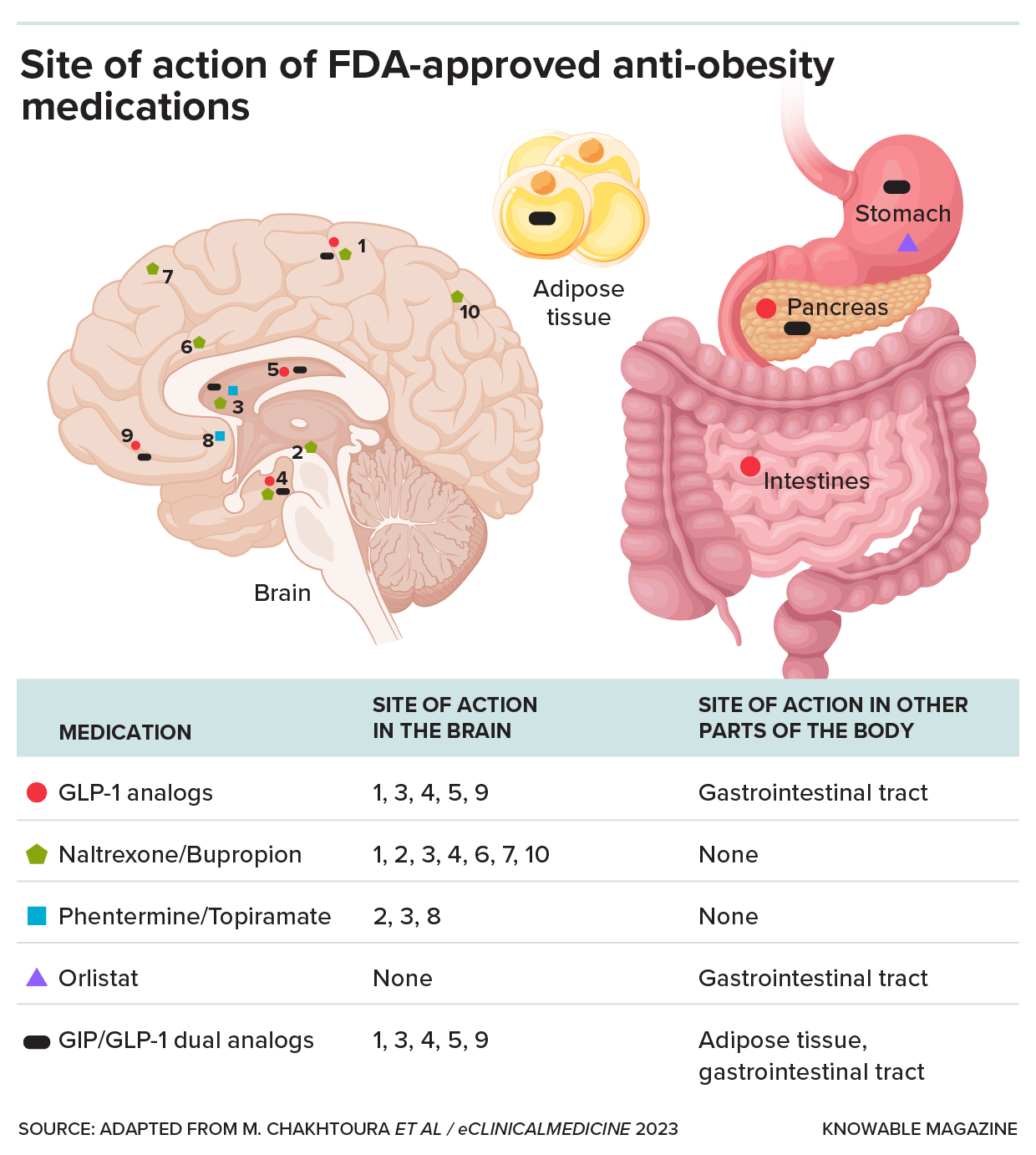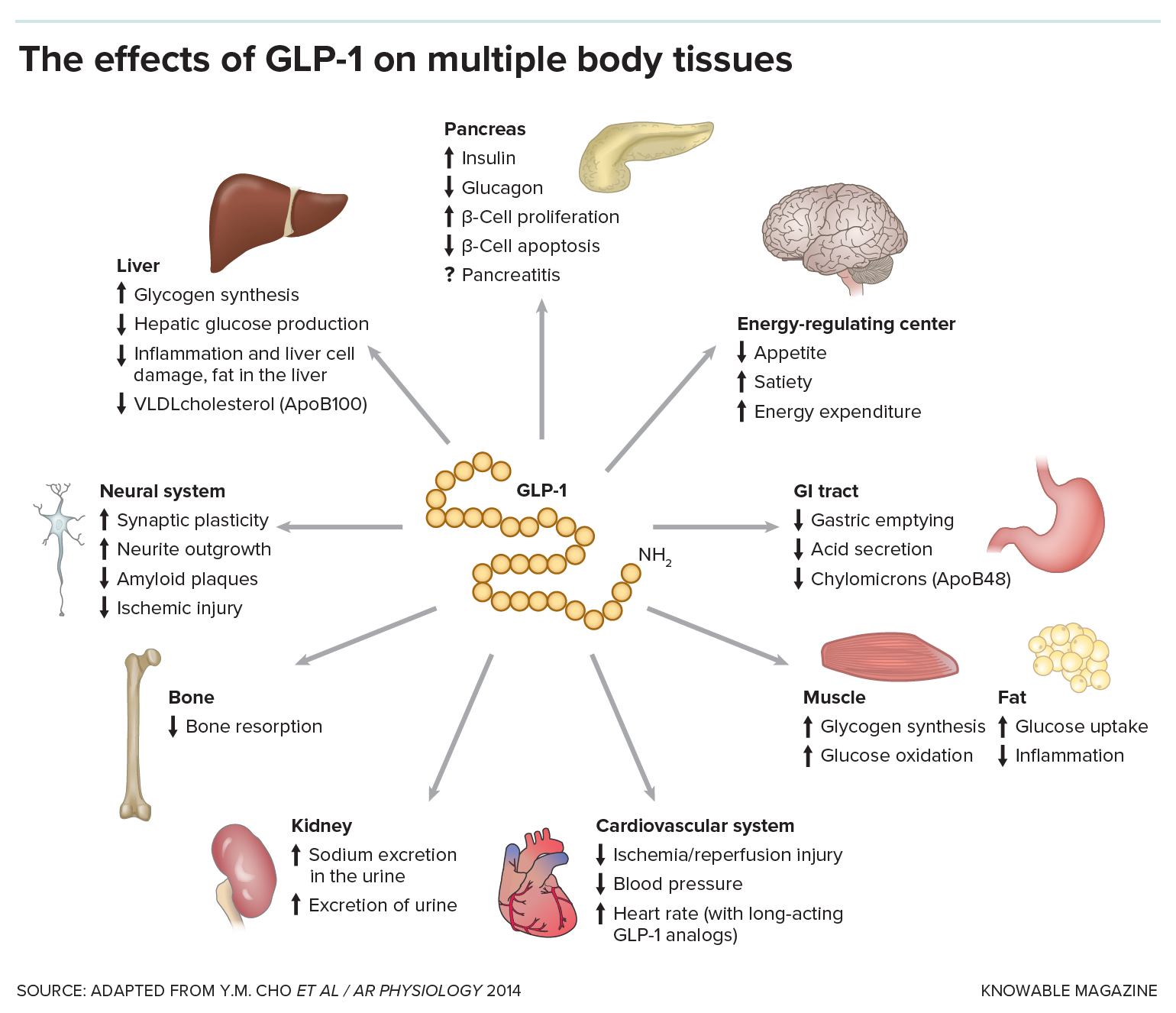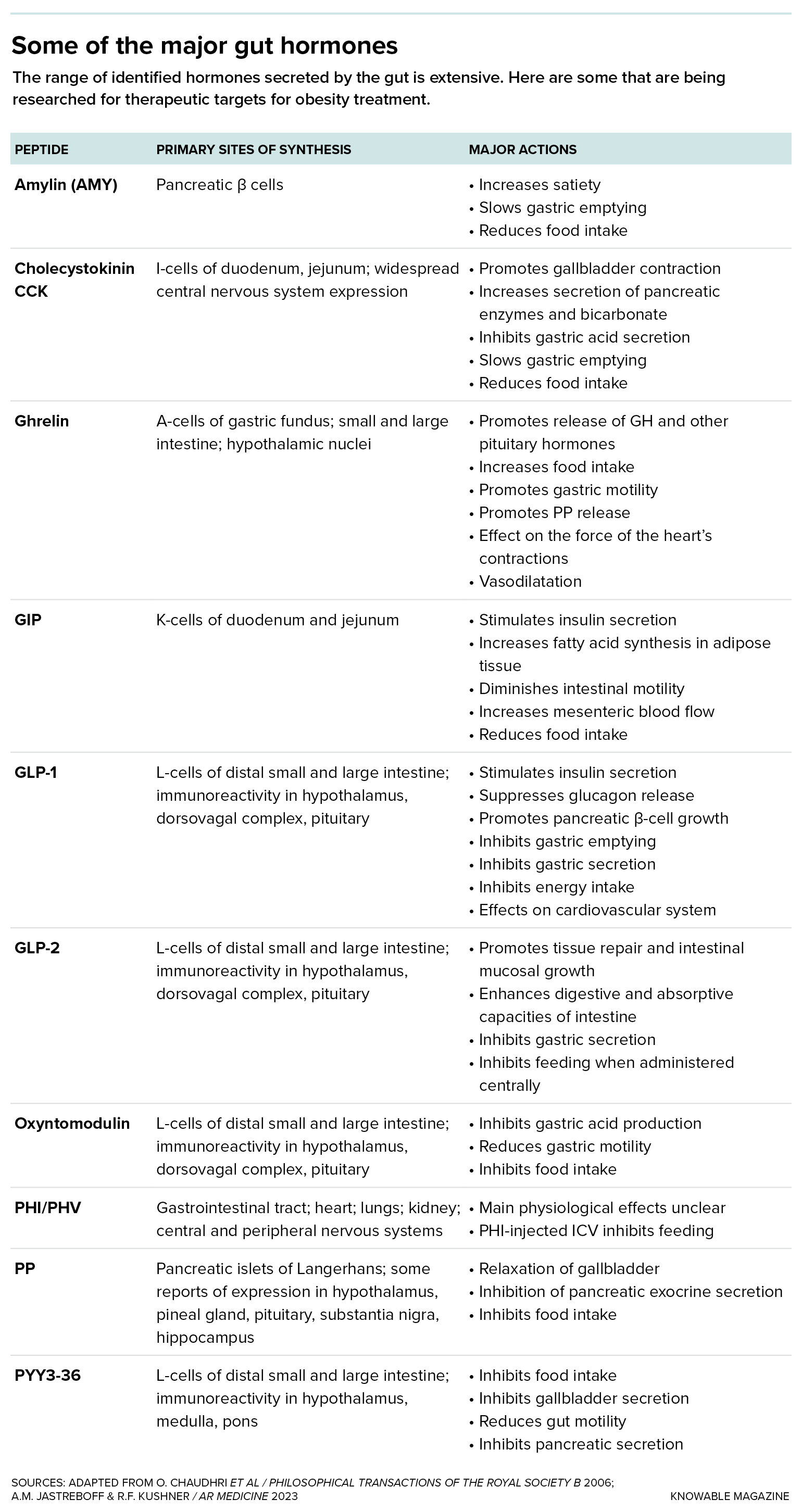What’s next in the Ozempic era?
Diabetes, weight loss and now heart health: A new family of drugs is changing the way scientists are thinking about obesity — and more uses are on the horizon
Support sound science and smart stories
Help us make scientific knowledge accessible to all
Donate today
Few drugs have achieved the stardom that semaglutide, marketed in the United States as Ozempic or Wegovy, has today. A synthetic, injectable version of an intestinal hormone, it is the flagship of a new category of drugs initially developed for diabetes that rose to fame in the medical and public arena as an effective weapon against obesity. Semaglutide has proved so successful that its manufacturer, the Danish company Novo Nordisk, is unable to keep up with demand.
The US Food and Drug Administration approved semaglutide in 2017 to improve the control of blood sugar levels in adults with type 2 diabetes — and then, in June 2021, for chronic weight management in adults who are obese or overweight and have related risk factors, such as high blood pressure or diabetes.
Social networks boosted the drug’s fame: In mid-2022, a viral TikTok clip claimed Kim Kardashian had used semaglutide to lose 15 pounds so that she could wear an iconic Marilyn Monroe dress to the Met Gala in New York. In the months that followed, everyone from former British Prime Minister Boris Johnson to billionaire entrepreneur Elon Musk acknowledged resorting to the medication to tamp down their appetites and slim down. Today, three out of four Americans say they have heard of this type of drug — and of those, more than half consider it a good option for weight loss, according to a Pew Research survey.
Last November, however, the ones with their eyes on the drug were cardiologists. At the opening of the 2023 annual meeting of the American Heart Association in Philadelphia, results of a clinical trial generated tremendous interest: Semaglutide, it appeared, was a new tool to treat heart disease.
The trial, called SELECT, was conducted in 41 countries with more than 17,000 people who were overweight or obese and at high cardiovascular risk but who didn’t have diabetes. It found that a weekly subcutaneous injection of 2.4 milligrams of semaglutide can, in addition to helping people lose an average of 15 percent of their original weight, reduce the risk of heart attack, stroke or death by 20 percent. It’s a magnitude of effect that puts it in the same category as other drugs that prevent cardiovascular events, such as low-dose aspirin, antihypertensives and statins to lower cholesterol.
From the study, scientists could calculate the total number of people who would need to be treated to produce the desired benefit in one of them. They found that treating 67 diabetes-free overweight or obese patients at high risk of a cardiovascular event for 40 months would prevent one major cardiovascular event, such as heart attack or stroke, or death due to heart disease. By way of comparison, this is the same number of patients with a cardiovascular history who must take aspirin or hypertension drugs for 60 months to avoid one stroke.

Semaglutide, marketed as Ozempic (pictured) or Wegovy, is an injectable drug approved by the US FDA for the treatment of type 2 diabetes, obesity and cardiovascular disease.
CREDIT: FCM82 / SHUTTERSTOCK
Based on the study results, in early March the FDA approved the use of injectable semaglutide to reduce the risk of cardiovascular death, myocardial infarction and stroke in adults with cardiovascular disease who are obese or overweight.
“It’s a milestone. For the first time, we have a drug, semaglutide, that not only causes weight loss, but also reduces the formation of atherosclerotic plaque and prevents deaths and cardiovascular events,” says Paola Harwicz, a cardiologist and obesity specialist in Buenos Aires who headed the Cardiometabolism Council of the Argentine Society of Cardiology and participated in the meeting in Philadelphia.
Several studies suggest that the drug reduces the buildup of plaque in the arteries; in one of them, in patients with type 2 diabetes, four months of treatment with semaglutide reduced carotid artery thickness, a clinical marker of atherosclerosis, by 13 percent.
A role for semaglutide and related drugs in staving off cardiovascular disease — the cause of one in three deaths worldwide — further boosts the drug’s prospects in the market by vastly expanding the universe of specialists who can prescribe it. It also repositions being overweight as one of the main truly modifiable risk factors for cardiovascular disease.
Dealing with extra pounds
According to the classic medical approach, to lose weight there must be an imbalance between calories taken in and calories burned: You either eat fewer or expend more. But in the last 30 years, new evidence has shown it is far more complicated than that, says Julio César Montero, a medical nutritionist and president of the Argentine Society of Obesity and Eating Disorders.
The emerging thinking among those working in this field, and reflected in a statement by the Endocrine Society, is that obesity is due to two related but distinct processes: the already mentioned energy imbalance (eating more calories than the body expends) and the resetting of the body weight “set point” — the weight that the body determines as its goal — to a higher value.
People with obesity have a disorder of the energy homeostasis system, the biological process that maintains weight stability by actively matching energy intake to energy expenditure over time. Thus, the body responds to weight loss by tenaciously trying to regain the lost pounds and return to its (higher value) target weight.

All current FDA-approved anti-obesity medications contribute to weight loss, although the results vary from one to another. Most of these compounds act at the brain level, to reduce appetite and increase satiety, and at the gastrointestinal level, to slow gastric emptying, promote insulin release or block fat absorption.
The mechanism behind the body’s quest to return to its body weight set point is not yet fully understood, but it explains why it is so difficult to achieve an effective treatment to manage obesity. It is estimated that only one in five people who lose between 5 and 10 percent of their initial weight through diet and exercise in six months manage to keep off the weight for more than a year. Losing and sustaining weight loss isn’t made easier by modernity’s sedentary way of life and the wide range of readily available ultraprocessed foods. By 2035, it’s projected that more than half of the world’s population will be overweight or obese.
Until now, traditional anti-obesity drugs have had limited effectiveness. Most act on brain-signaling chemicals — neurotransmitters — to reduce appetite, an approach pioneered in the 1960s with the use of amphetamines that has continued to today with safer derivatives and some other, nonamphetamine, drugs. Another often-used drug is orlistat (marketed as Alli or Xenical), which reduces fat absorption from food.
But for all of these, the effects over the short and medium term are relatively modest, achieving a reduction of 6 percent to 10 percent of a person’s starting weight. Moreover, adverse effects, ranging from insomnia, nervousness and increased blood pressure to diarrhea and fecal incontinence, limit their widespread use.
The role of hormones
In search of new ways to understand and treat obesity, in recent decades scientists have turned their gaze to the hormones secreted by the intestine.
Specifically, research has focused on a group of 10 hormones that have roles in optimizing the process of digestion and absorption of nutrients from the food we eat. They are also how the gastrointestinal tract sends signals to the brain about the body’s energy status, in many cases influencing metabolism and contributing to the regulation of our appetites.
The new strategy “has changed the therapeutic landscape of obesity to target underlying mechanisms” and spurred “an auspicious new era of highly effective drugs,” write endocrinologist Ania Jastreboff of Yale School of Medicine and her colleague Robert Kushner of Northwestern University in a 2023 article in the Annual Review of Medicine.

Clinical studies have found semaglutide (Ozempic) to be more effective than other available drugs — such as exenatide (Byetta), sitagliptin (Januvia), dulaglutide (Trulicity) and insulin glargine (Lantus) — in lowering blood sugar values in people with type 2 diabetes.
CREDITS, CLOCKWISE FROM TOP LEFT: MEHMET CETIN, I VIEWFINDER, BIRGIT REITZ-HOFMANN, CAROLINE RUDA / SHUTTERSTOCK
One such hormone is glucagon-like peptide type 1, or GLP-1, discovered in the 1980s. Semaglutide, the active molecule in Ozempic and Wegovy, is a lab-made lookalike that mimics the action of GLP-1. Like GLP-1 itself, and like an earlier drug, liraglutide, that was approved in 2010, it suppresses the release of glucagon — a hormone secreted by the pancreas to raise blood sugar levels. It also promotes the growth and function of pancreatic beta cells, which are responsible for producing insulin, the hormone that ensures that sugar from food enters the body’s cells to give them energy.
Both of these actions regulate blood sugar levels, which is why these drugs were initially intended to tackle diabetes. A series of clinical trials called SUSTAIN, which evaluated the drug in about 8,000 patients with type 2 diabetes, showed that semaglutide is more effective than other available drugs (sitagliptin, marketed as Januvia; exenatide, or Byetta; dulaglutide, or Trulicity; and insulin glargine, or Lantus) in reducing glycosylated hemoglobin scores — a test that measures average blood glucose levels over the prior three months. Maintaining blood sugar levels within the target range is a goal in the treatment of diabetes to avoid complications.
But it was soon realized that these drugs came with a bonus, since GLP-1 doesn’t act only on the pancreas. It also acts on centers in the brain that control appetite. And it decreases stomach movements and emptying, so people feel full for longer. These two mechanisms contribute to reducing food intake, but, unlike older anti-obesity drugs, “they do so in a more physiological way, with few adverse effects,” says Montero. One of the best effects, he adds, is that they take away suffering, because they assuage food cravings. Patients report a reduced desire to eat highly seasoned and salty foods, or foods rich in carbohydrates, as well as a better ability to resist urges.

Semaglutide, the active molecule of Ozempic and Wegovy, is a synthetic version of glucagon-like peptide type 1 or GLP-1. The functions of GLP-1 in the body are numerous, acting on the pancreas, stomach, gastrointestinal tract, kidneys, bones, heart, liver, muscle and adipose tissues, the energy-regulating center of the brain, and the rest of the neural system.
For Harwicz, semaglutide can be a facilitator that helps people make better decisions. One of her patients, a man weighing more than 160 kilograms (over 350 pounds) with a history of diabetes who had failed multiple previous attempts to lose weight, was able to lose 35 kilos (77 pounds) — more than 20 percent of his body weight — with weekly injections of the drug, along with dietary education and a tailored physical activity plan. “He really feels like he’s succeeding because the medication is helping him,” she says. “It’s important to modify lifestyle; medication isn’t magic. But people can make better food choices and reduce the amount they eat with a lot more peace of mind.”
Of course, like any drug, semaglutide does not work in all patients, nor is it tolerated by all. In the SELECT study, for example, 16.6 percent of participants receiving semaglutide dropped out of the trial because of adverse effects, mainly digestive problems such as nausea, vomiting and diarrhea.
More in the pipeline
Everything indicates that the injections of semaglutide are just the beginning in this new era of weight loss drugs. In addition to a high-dose oral version of semaglutide that showed promising effects in trials and is on the horizon for approval, a tsunami of clinical trial results is anticipated for new drugs that also operate on the gut-brain axis and re-create the action of other intestinal and pancreatic hormones.
One of these is glucose-dependent insulinotropic polypeptide (GIP), which promotes insulin release after meals and reduces appetite. Another hormone is glucagon, which counterbalances the action of insulin by raising blood sugar, helps eliminate fat from the liver and increases satiety. And a third is amylin, which delays stomach emptying, accelerates satiety and decreases the desire to eat.
Collectively, such therapies have been dubbed “nutrient-stimulated hormone-based treatments” because they mimic the action of hormones that are released or function when specialized sensor cells in the digestive tract detect food intake. And they promise to enhance slimming effects, alone or in combination, partly through a physiological reset that prevents the body from stubbornly returning to a weight range that seems predetermined. In other words, it reduces the body’s tendency to regain the lost pounds.
One of the newer drugs, tirzepatide from Eli Lilly (marketed as Mounjaro or Zepbound), acts both on GLP-1 and GIP receptors. It obtained FDA approval November 2023 for the treatment of obesity. One of the clinical studies of this drug reported an average decrease of 25.3 percent of initial weight in those who received a weekly injection for 88 weeks.
Another experimental drug from Eli Lilly, retatrutide — dubbed “triple G” because it acts on GLP-1, GIP and glucagon receptors — could be next on the list. Last June, a study led by Jastreboff reported weight declines never before seen with a single drug. Patients without diabetes averaged a 24 percent body weight loss in just 48 weeks (11 months). And in the group receiving the highest dose, one-fourth of the patients dropped more than 30 percent of their weight. That’s close to the results of highly effective, but more drastic, bariatric surgery.
“I never imagined that physicians would have to worry about our patients losing too much weight when taking an anti-obesity drug,” Kushner says. “This is really an interesting turning point in obesity science and practice, an important paradigm shift in how we think about and manage people living with obesity.”
Kushner and Jastreboff suggest in their article that combining various members of these hormone-based drugs could target the many intertwined mechanisms of obesity. Montero agrees: “There is a swarm of hormones that form a spider web. And touching more than one thread at a time may move the web better, potentiating the effect and making interventions more comfortable, with fewer adverse events,” he says.

A number of gut hormones have attracted scientific attention as potential therapeutic targets for the management of obesity.
What is more, semaglutide and tirzepatide could also have benefits in other diseases, such as alcohol abuse disorder and other compulsive or addictive behaviors, such as smoking, excessive shopping and nail-biting. The drugs also reduce inflammation, which could help to limit damage to various organs and structures, such as the kidneys and joints. There are also preliminary studies of the effects of the drug in preventing cancer, and for the treatment of Parkinson’s and Alzheimer’s, although further studies are still needed to confirm their results. Writing in 2023, the editors of the journal Science declared that no scientific breakthrough in that year had been so transformative in so many fields, affecting everything from financial markets to popular culture.
But, as with any medical innovation, unavoidable challenges also loom on the horizon. Although the visible adverse effects of GLP-1 receptor agonists — nausea, vomiting, constipation and diarrhea — are usually mild and limited to the gastrointestinal tract, other more unusual but serious complications have raised concerns, such as a possible increased risk of pancreatitis. In addition, animal studies (not yet demonstrated in humans) suggest that there is a link to thyroid cancer risk.
Another barrier is the cost of these drugs. In the United States, a monthly treatment with semaglutide costs almost $1,000; the price drops almost 10-fold in countries such as Japan, the United Kingdom and Australia. In Latin America, where obesity rates have grown faster than in other parts of the world, the drug remains unaffordable for the bulk of the population. In Argentina, for example, in March an Ozempic pen with four doses of 1 mg cost 409,000 pesos, which is equivalent to more than twice the monthly minimum wage. More than two pens per month would be required to reach the 2.4 mg per week dose used in the SELECT cardiovascular prevention study.
To make matters worse, studies show that the benefits on weight fade or diminish sharply when the treatment is stopped, so it would have to be continued long-term. Research published in 2022, for example, found that patients regained two-thirds of their lost weight within a year of stopping medication.
“Our enthusiasm as clinicians with these drugs wanes if you think about it from a public health point of view,” says Patricio López Jaramillo, an endocrinologist, researcher and rector of the University of Santander in Bucaramanga, Colombia. He thinks that the use of the drugs should be placed within a broader societal package that extends beyond “the rational, linear and disciplinary vision” of medical specialists.
“New anti-obesity drugs should be considered as a useful tool, if financial access is improved,” he says. “And [use] must be framed within global actions and programs that allow populations to have real possibilities to practice healthy lifestyle habits, such as exercising, following a balanced diet and staying away from smoking.”
Kushner says physicians need to reexamine the kind of lifestyle advice given to people receiving these new drugs, de-emphasizing calorie counting and daily weigh-ins. More focus should be placed on health impacts rather than weight loss, high-quality protein intake should be encouraged, and the importance of physical activity and resistance exercise to preserve muscle mass should be emphasized.
One option could be to use tests to predict which patients will have better results with the various medications and who, perhaps, should think about surgery or other approaches. “Not all patients respond to treatment,” says Andrés Acosta, an Ecuadorian physician and researcher who heads the Precision Obesity Medicine Laboratory at the Mayo Clinic in Rochester, Minnesota. It is important to identify those who would benefit most, he adds.
Acosta cofounded a company that last year launched a test that identifies patients with a feature called “hungry gut” — those who move food quickly from their stomachs and, consequently, lose satiety faster. This could be a subgroup that particularly benefits from these new anti-obesity drugs, he hypothesizes. For a drug market that could be worth $100 billion by 2030, it wouldn’t hurt to ensure that resources are invested in the patients who will get the most from them.
Article translated by Debbie Ponchner
Editor’s note: This article was updated on April 17, 2024, to correct the location of the Mayo Clinic. It is in Rochester, Minnesota, not Rochester, New York, as originally stated.
10.1146/knowable-041724-1
TAKE A DEEPER DIVE | Explore Related Scholarly Articles




